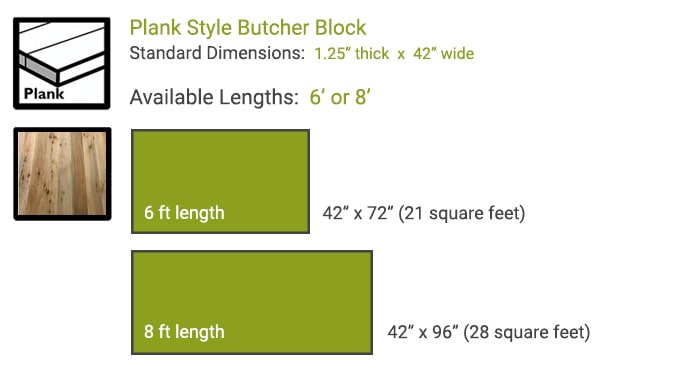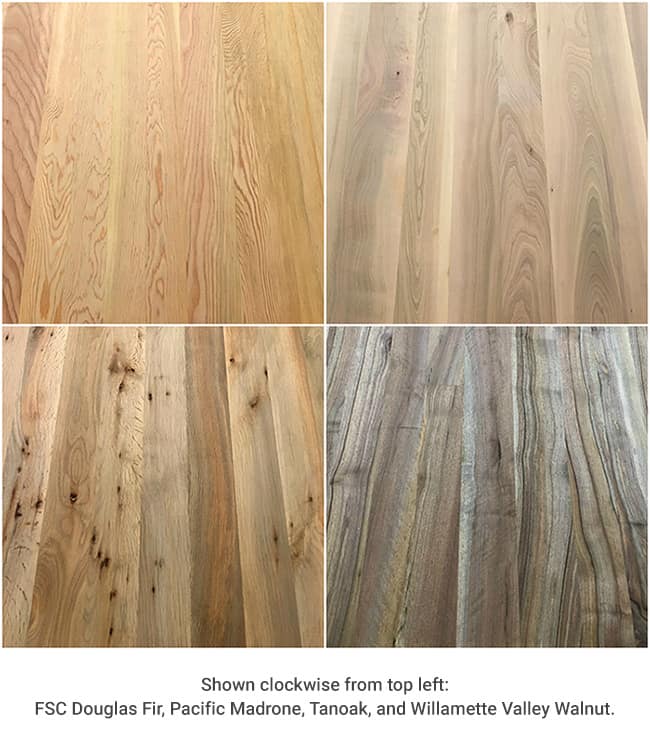Tanoak Butcher Block Countertop - PLANK - UNFINISHED
1-1/4" thick x 42" wide6' or 8' lengths
Unfinished Butcher Block
PLEASE CALL TO OBTAIN A QUOTE, A SHIPPING ESTIMATE, OR TO PLACE AN ORDER

Purchase
Call for price
Description
Tanoak Butcher Block Solid Wood Countertop
ALL DOWNLOADS
- Butcher Block Installation and Care & Maintenance Guide
- Butcher Block VOC Emission Test Certificate
- Butcher Block Limited Warranty
There is nothing like an old-fashioned, butcher block island countertop for the warmth, color, and feel of a solid hardwood surface. The island becomes the center of the kitchen, where everyone congregates while meals are being made. Or overhang one side, stash a few stools underneath, and it becomes a wonderful place to sip coffee while the kids eat breakfast.

Tanoak
Tanoak, also known as California Chestnut, is a special hardwood species native to Southern Oregon and Northern California. The wood that is actually part of the beech family offers significant character including grain variations and tight knots, paired with warm honey and chocolate brown tones. A unique evergreen hardwood, our tanoak has been salvaged from chip yards, where the wood is otherwise turned into pulp. It grows in the Siskiyou and Coast Ranges of Southern Oregon and Northern California.
Plank
Plank-style tops really highlight the beauty, color, and grain patterns of our local wood species. Plank-style construction shows off more of the unique grain patterns and figuring that make each type of wood special. Flat plank face up is not the hardest orientation of the wood, but it's a great style to choose when you want an antique distressed look. The plank-style tops are made with much wider pieces of wood, up to 8" wide; butcher block is traditionally made of thinner staves, smaller than 1 1/2" wide.

Cut-To-Size, Unfinished
Our standard butcher block is unfinished, cut-to-size (6' or 8' lengths), and sanded to approximately 120 grit with square edges.However, all unfinished tops can be quoted with fabrication, installation, and finish - just contact us for details!
Or Completely Customizable
We make butcher block of any thickness, any width and any length.The sky's the limit when it comes to our custom capabilities. Use our COUNTERTOP ESTIMATE FORM to request a quote for your vision and we'll help guide the finished product based on production reality and cost.
Custom Options include:
- Edge Details
- Custom Thickness
- Any width or length
- Under or top mount sink/stove cutouts
- Pre-joining edges or seams
- Backsplash
- Electrical wiring chase
- Custom and stacked edge profiles
- Curves or custom shapes
- Knife slots
- Integral drainboards

Finishing your Butcher Block
We offer the perfect blend of Pure Tung Oil and Citrus Solvent for finishing your wooden surface.Find our Half & Half finish by The Real Milk Paint Co. HERE and watch the video tutorial below!
HOW TO FINISH A WOODEN COUNTERTOP
Care and Maintenance of a Butcher Block
Some clients use their butcher blocks as a large cutting board, others treat them like fine furniture. In either case, simply wipe clean with a moist sponge after use. Avoid harsh detergents and puddles of standing water. That's it! Letting the butcher block dry out because of a lack of oil is the top cause of problems with butcher block. Periodically oil the butcher block with your choice of food-grade plant or mineral oil. A good rule of thumb is once a week for the first month and then a minimum of monthly thereafter. The frequency of oiling will depend largely on the species of wood, how you use it and what finish was applied. Basically, if the wood appears dry, it's time to oil it.
DOWNLOAD OUR BUTCHER BLOCK INSTALLATION & CARE GUIDE
Natural Oil
Natural Oil finished tops are food grade, you can cut right on them like a cutting board. Because wood is a natural, living material, it continually absorbs more oil, so regular re-oiling will be necessary to maintain its luster. Re-oiling is simple -- just spread oil evenly over the surface, allow it to soak in for about 5 minutes then wipe the excess off with a clean rag. It's that easy!If light scratches occur, sand the surface gently with 220-grit sandpaper and reapply your food-safe oil.
READY TO START THE PROCESS? START WITH OUR ONLINE COUNTERTOP ESTIMATE FORM - JUST CLICK THE “GET A QUOTE” BUTTON BELOW!

























